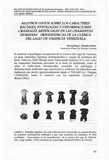| dc.rights.license | http://creativecommons.org/licenses/by-nc-sa/3.0/ve/ | es_VE |
| dc.contributor.author | Brites, Natasha | |
| dc.date.accessioned | 2020-03-10T16:40:39Z | |
| dc.date.available | 2020-03-10T16:40:39Z | |
| dc.date.issued | 2020 | |
| dc.identifier.issn | 2542-3304 | |
| dc.identifier.uri | http://www.saber.ula.ve/handle/123456789/46665 | |
| dc.description.abstract | La investigación indaga sobre algunas características presentes en las osamentas humanas prehispánicas excavadas en la Cuenca del Lago de Valencia. Este trabajo se base en el sondeo de fuentes escritas (Archivos, fichas, bibliografía, etc.) y en materiales osteológicos del área (Colección de Antropología Física de la Fundación Museo de Ciencias). El estudio nos permitió evidenciar tres aspectos: A) Caracteres raciales: presencia del “diente de pala” y del “hueso del Inca”. Esto parece reafirmar que las poblaciones nativas tienen un origen mongoloide y asiático. B) Patologías o enfermedades: presencia de afecciones dentales, de la dieta, tuberculosis vertebral, entre otras patologías. Se rompe con la creencia de la ausencia de tales enfermedades entre los indígenas que habitaron el área, las mismas ya existían con anterioridad a la llegada de los colonizadores europeos. C) Deformaciones craneales artificiales: presencia de cráneos tabulares erectos y tabulares oblicuos. Estas deformaciones intencionales deber haber tenido múltiples significados (marcador étnico, diferenciador de estatus y rol, papel religioso, concepción estética, etc.) que están relacionados con la cosmovisión grupal. | es_VE |
| dc.language.iso | es | es_VE |
| dc.publisher | SaberULA | es_VE |
| dc.rights | info:eu-repo/semantics/openAccess | es_VE |
| dc.subject | Arqueología | es_VE |
| dc.subject | Osteología cultural | es_VE |
| dc.subject | Paleopatología | es_VE |
| dc.title | Algunos datos sobre los caracteres raciales, patologías y deformaciones craneales artificiales en las osamentas humanas prehispánicas de la Cuenca del Lago de Valencia-Venezuela | es_VE |
| dc.title.alternative | Some data on the racial characters, pathologies and artificial cranial deformities in Pre-Hispanic human bones of the lake basin of Valencia-Venezuela | es_VE |
| dc.type | info:eu-repo/semantics/article | es_VE |
| dc.description.abstract1 | A study of some characteristics of Pre-Hispanic human bon4es excavated in the Lake Valencia basin, based on research into written sources (archives, cards, bibliography, etc.) and on osteological materials from the area (Physical Anthropology Collection of the Science Museum Foundation). Three aspects of the subject stand out: A) Racial characteristics: presence of the “shovel tooth” and the “Inca bone”, which seems to reconfirm that the native populations are of Mongoloid and Asiatic origin. B) Pathology or diseases: presence of dental and dietetic diseases, vertebral tuberculosis, among other pathological conditions. This refutes the belief in the absence of these diseases among the indigenous people of the area; they existed, in fact, before the arrival of the European colonizers. C) Artificial deformities of the cranium: presence of erect tabular crania and oblique tabular crania. These intentional deformities must have had many meanings (race markers, distinguishers of status and role, religious and aesthetic significance, etc.) related to group’s Cosmo vision. | es_VE |
| dc.description.colacion | 31-50 | es_VE |
| dc.description.paginaweb | www.saber.ula.ve/boletin_antropologico | |
| dc.identifier.edepositolegal | ppi201403ME788 | |
| dc.publisher.pais | Venezuela | es_VE |
| dc.subject.institucion | Universidad de Los Andes | es_VE |
| dc.subject.keywords | Archaeology | es_VE |
| dc.subject.keywords | Cultural osteology | es_VE |
| dc.subject.keywords | Paleopathology | es_VE |
| dc.subject.seccion | Boletín Antropológico: Artículos | es_VE |
| dc.subject.tipo | Monografías | es_VE |
| dc.type.media | Texto | es_VE |


